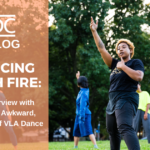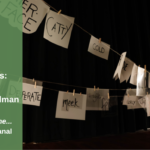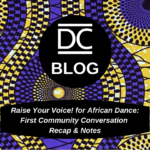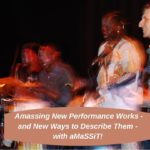Sylver Rochelin Randrianantenaina is a professional dancer from Madagascar, having spent the last decade specializing in Malagasy popular dances, Afropop, Caribbean, Hip Hop, Jazz and contemporary. He has performed with many of Madagascar’s most renowned musicians and performers, and has danced with a number of contemporary companies in Madagascar and around the world. Sylver is a Teaching Artist at The Dance Complex and teaches weekly classes in Froca Fitness. Work Study Victoria Torres recently sat down with Sylver to learn more about these experiences in his own words.
Q: What is Froca Fitness? Can you speak a little bit on the genre and where it comes from?
A: Froca Fitness is a type of cardio dance fitness. It comes from Africa and the Caribbean, mostly. It’s very intense since it’s a cardio dance, so when you take class you will dance from the beginning to the end. It’s very on-the go, you just follow what the instructor is doing, so the more you come to class the more you get the music and the steps. I use roughly the same music for at least a month, and then I’ll rotate music every once in a while, and add new stuff.
Q: What kind of role does technique play in Froca Fitness? Could you describe Froca Fitness technique?
A: What I put in my choreography is everything I’ve learned throughout the years. I’ve been trained in African traditional dance, ballet, and a little bit of hip hop as well, so you will see that in my class. Mostly, the technical dance form is Malagasi dance from Madagascar, which is where I’m from. The heaviest part of the technique is Malagasi, but I’ve been trained in several other styles, so you see that as well.
Q: Can you speak on your journey as an Artist, from Madagascar to Jerusalem and now to Cambridge?
A: I’ve been dancing my whole life, since I was a kid, but I actually didn’t take my first dance class until I was 20. At the same time, I also started to dance professionally as a backup dancer for singers in Madagascar. I was also doing normal school on the side, like everybody else, so I was dancing and studying at the same time.
When I finished my academic schooling, I was selected as a trainee to go to Senegal. I trained there for three months, dancing every day and training. When I came back to Madagascar, that was when I realized I had to move abroad. I went to Israel to study ballet for two years, which was very challenging for me because I’d never been trained in ballet before that. It was quite challenging, but very interesting and inspiring. It opened up a lot what I could do with dance.
Q: How do you feel that traveling and multiculturalism influences the way you teach and approach dance?
A: Dance has always been a big part of my life, and I owe a lot of things to dance. I’ve been able to see the world because of dance. I’ve been able to travel because of dance. Because I was performing and traveling with pop singers. I’ve been many places because of dance. I owe a lot to dance, my health, my body, my mental wellness. When I teach class I really want to bring that to my students, that wellness, that joy, just the well-being overall that comes from dancing.
Q: What do you think makes the Dance Complex a special place for you and for your students?
A: The Dance Complex is a very welcoming place for all kinds of people, young, young adult or old, all kids of race, all kinds of genres. Everyone is welcome. You just feel so comfortable here, you can be whatever you want. There’s this big sense of community that I also want to bring into my class. I want my students to make friends in class, to meet new people. It’s a place where everyone can just come together, whatever you are coming from because of dance, because of this space. The other day I was teaching a class, inside the class it was hot and everyone was sweating and smiling and shaking it, but outside it was snowing. I just thought “This is beautiful” and I took a moment to just enjoy that.
Blog post by Dance Complex Work Study Victoria Torres





